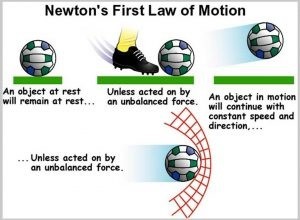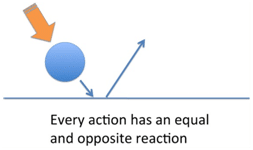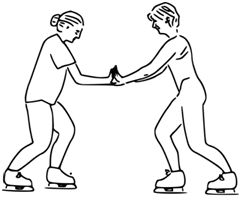Newton’s Laws of Motions
Grade 7 Science Worksheets
Newton’s first law of motion
Newton’s first law of motion states that every object will remain at rest or in uniform motion in a straight line unless acted upon by an external force to change its motion.

Newton’s second law of motion
Newton’s second law of motion is as follows: The acceleration of an object as obtained by a net force is directly proportional to the size of the net force, in the same direction as the net force, and inversely proportional to the mass of the object.
Newton’s third law of motion
Newton’s third law of motion states that: For every action, there is an equal and opposite reaction. This means that in every interaction, there is a pair of forces acting on the two participating objects.
Here action is the ball thrown on the ground …The ball bounces back is the reaction.

In the above picture : Skater on the left pushes the skater on the right (action). In turn the skater on the left gets pushed by the skater on the right (reaction).

Learn more about Newtons Laws of Motions and other important topics with 7th Grade Science Tutoring at eTutorWorld. Our expert science tutors break down the topics through interactive one-to-one sessions. We also offer the advantage of customized lesson plans, flexible schedules and convenience of learning from home.
Personalized Online Tutoring from eTutorWorld
eTutorWorld offers affordable one-on-one live tutoring over the web for Grades K-12, Test Prep help for Standardized tests like SCAT, CogAT, MAP, SSAT, SAT, ACT, ISEE and AP. You may schedule online tutoring lessons at your personal scheduled times, all with a Money-Back Guarantee. The first one-on-one online tutoring lesson is always FREE, no purchase obligation, no credit card required.
For answers/solutions to any question or to learn concepts, take a FREE TRIAL Session.
No credit card required, no obligation to purchase.
Just schedule a FREE Sessions to meet a tutor and get help on any topic you want!
Check Point
A. State True or False
- Newton’s third law states that every object will remain at rest or in uniform motion unless acted upon by an external force to change its motion.
- The acceleration of an object as obtained by a net force is directly proportional to the magnitude of the net force, in the same direction as the net force.
- Newton’s third law states that every action is just an action with no expected reaction.
- The law of conservation of mass is same as Newton’s law.
- An object in motion will continue to be in motion unless acted upon by an external force to change its state.
B. Fill in the blanks
- Newton’s first law states that every object will remain at ……… or in uniform motion in a …………… line unless compelled to change its state by the action of an …………………..
- Newton’s third law is for every ……….., there is an equal and opposite………..
Answer Key
A. True or False
- False
- True
- False
- False
- True
B. Fill in the blanks
- Rest, straight, external force
- Action, reaction
Learn more about Scientific Method and other important topics with 7th Grade Science Tutoring at eTutorWorld. Our expert science tutors break down the topics through interactive one-to-one sessions. We also offer the advantage of customized lesson plans, flexible schedules and convenience of learning from home.
Pricing for Online Tutoring
| Tutoring Package | Validity | Grade (1-12), College |
|---|---|---|
| 5 sessions | 1 Month | $124 |
| 1 session | 1 Month | $25 |
| 10 sessions | 3 months | $239 |
| 15 sessions | 3 months | $354 |
| 20 sessions | 4 months | $449 |
| 50 sessions | 6 months | $1049 |
| 100 sessions | 12 months | $2049 |
6th Grade Free Worksheets
- Elements & Compounds
- Solar Energy
- Photosynthesis
- Digestive System
- Electricity and Magnetism
- Law of conservation of energy
- Law of Conservation of Mass
- Periodic table
- Properties of Matter
- Waves
- Energy Resources
- Weather and Climate
- Immune, Circulatory and Digestive Systems
- Organs in Multi-cellular Organisms
- Sedimentary, Igneous, and Metamorphic Rocks
- Structure of the Earth
- Physical and Chemical Changes
- Scientific Method
- Cycles in Nature
- Environmental Science
- Renewable and Non-renewable energy Resources
- Characteristics of Living Organisms
- Life Science
- Earth and Space Science
- Solar Eclipse
- Heat Technology
- Newton’s Laws of Motions
- Physical Science
- Tools, Measurement and SI Units
- Earth Atmosphere
- Interactions of Living things
- The Earth Ecosystem
- Organelles in Plant and Animal cells
- Layers of the Earth


